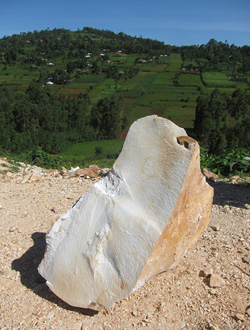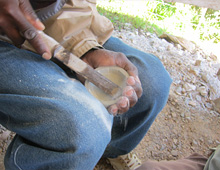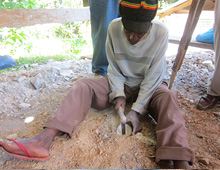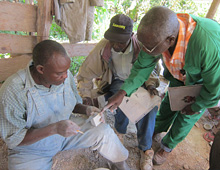#05 We visited the production site that has been supplying us for three years.
This time, I would like to report the production site of our project, which has become the third year since it started. This time we feature following four products: whose theme is desktop accessories of Pen stands and Trays that are carved items in motif of elephants and giraffes living in Kenya. In this column, I would like to introduce how these products are made.
 Pen stands and Trays scheduled for sale in 2013. The natural stone colors and designs are very beautiful.
Pen stands and Trays scheduled for sale in 2013. The natural stone colors and designs are very beautiful.
How the soap stone desktop accessories are made:
All the processes starting from digging stones, carving to polishing are handmade. They are longstanding and local producers who are working together cooperatively to make the products and we are moved by their sincere attitude of craftsmanship at the site. Here we would like to share the feeling with you by showing the pictures.
- 1.Dig the rocks that can be material of soapstone
- 2.Cut the large block into flat pieces according to the size of the product
- 3.Trace the flat piece of the stone with a pencil after taking the size of the products and then cut the stone
- 4.Carve the stone into a rough shape
- 5.Set the position of the animal in the stone and carve it.
- 6.Drill holes for pen stand.
- 7.Wash and sandpaper it.
- 8.Dry it in the sun.
- 9.Polish it with wax.
- 10.Packaging
1.Mining soapstone
 The surrounding area is an agricultural area with a lot of green.
The surrounding area is an agricultural area with a lot of green.

Break the rocks, or soap stone in the earth using a tool, and mine it in large blocks. Depending on the mining area, the color of stone differs as white, grey, pink, yellow and others, so does the hardness of the stone. Also there are different uses for industrial purpose and for carving (soft stones) depending on the mining areas. Our products are made of natural and soft soap stones.
 An unearthed block
An unearthed block
2.Shaping: Cut the large block into some flat pieces according to the size of the product.
In accordance with the size of the product, cut the large block into the pieces that are thick enough for products. In order to cut it straight, it requires experiences and skills.
The stone is cut into the pieces with proper thickness, and then it is further cut into smaller pieces to adjust the product size.
3.Trace the flat piece of the stone with a pencil after taking the size of the products and then cut the stone
4.Shaping: Carving it into rough shape first and then into final shape.
This process is to bring it to complete shape by taking the size of finished product. The later process requires more careful work as the carving of animal takes place.

5.Shaping: Set the position of the animal and carve it.
The animal templates were prepared by Ryohin Keikaku. Trace it with a pencil and carve it thinly.
6.Shaping: Drill holes of a pen stand
In this process, six holes are made using a drill.
 Only one craftsman does it using a special machine.
Only one craftsman does it using a special machine.
7.Washing, Polishing
8.Drying
After washing, it is sandpapered and then dried in the sun.
9.Waxing
Wax it by polishing agent for floors.
10.Packaging
Reuse the cardboard by turning the inside out and newspapers for wrapping.
All the work is done!
After the products were shipped to Japan, they are checked and packed again, then shipped to stores for display.
Now the products are being shipped and on their way from the port of Mombasa to Japan. All of us who are involved in this project are looking forward to them.













































